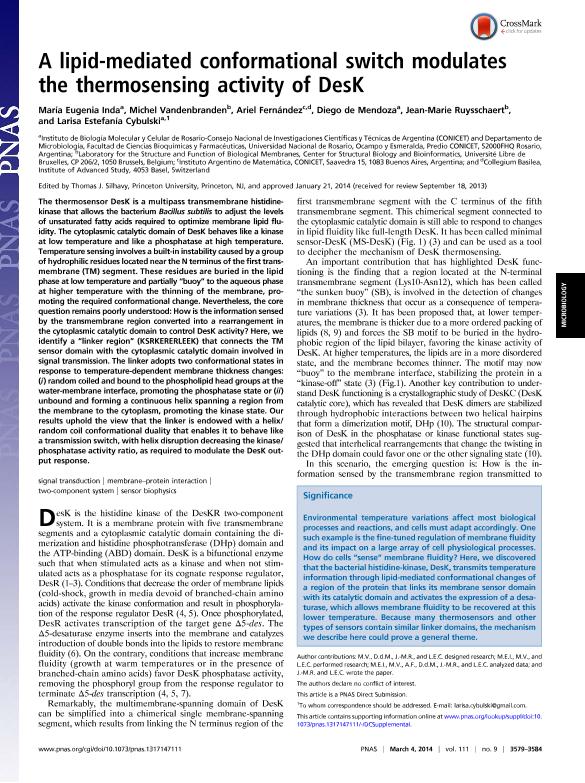Mostrar el registro sencillo del ítem
dc.contributor.author
Inda, María Eugenia

dc.contributor.author
Vandenbranden, Michel
dc.contributor.author
Fernandez, Ariel

dc.contributor.author
de Mendoza, Diego

dc.contributor.author
Ruysschaert, Jean Marie
dc.contributor.author
Cybulski, Larisa Estefania

dc.date.available
2016-09-09T21:44:11Z
dc.date.issued
2014-02
dc.identifier.citation
Inda, María Eugenia; Vandenbranden, Michel; Fernandez, Ariel; de Mendoza, Diego; Ruysschaert, Jean Marie; et al.; A lipid-mediated conformational switch modulates the thermosensing activity of DesK; National Academy Of Sciences; Proceedings Of The National Academy Of Sciences Of The United States Of America; 111; 9; 2-2014; 3579-3584
dc.identifier.issn
0027-8424
dc.identifier.uri
http://hdl.handle.net/11336/7607
dc.description.abstract
The thermosensor DesK is a multipass transmembrane histidine-kinase that allows the bacterium Bacillus subtilis to adjust the levels of unsaturated fatty acids required to optimize membrane lipid fluidity. The cytoplasmic catalytic domain of DesK behaves like a kinase at low temperature and like a phosphatase at high temperature. Temperature sensing involves a built-in instability caused by a group of hydrophilic residues located near the N terminus of the first transmembrane (TM) segment. These residues are buried in the lipid phase at low temperature and partially “buoy” to the aqueous phase at higher temperature with the thinning of the membrane, promoting the required conformational change. Nevertheless, the core question remains poorly understood: How is the information sensed by the transmembrane region converted into a rearrangement in the cytoplasmic catalytic domain to control DesK activity? Here, we identify a “linker region” (KSRKERERLEEK) that connects the TM sensor domain with the cytoplasmic catalytic domain involved in signal transmission. The linker adopts two conformational states in response to temperature-dependent membrane thickness changes: (i) random coiled and bound to the phospholipid head groups at the water-membrane interface, promoting the phosphatase state or (ii) unbound and forming a continuous helix spanning a region from the membrane to the cytoplasm, promoting the kinase state. Our results uphold the view that the linker is endowed with a helix/random coil conformational duality that enables it to behave like a transmission switch, with helix disruption decreasing the kinase/phosphatase activity ratio, as required to modulate the DesK output response.
dc.format
application/pdf
dc.language.iso
eng
dc.publisher
National Academy Of Sciences

dc.rights
info:eu-repo/semantics/openAccess
dc.rights.uri
https://creativecommons.org/licenses/by-nc-sa/2.5/ar/
dc.subject
Signal Transduction
dc.subject
Transmembrane Sensor
dc.subject
Conformational Switch
dc.subject
Kinase
dc.subject.classification
Biofísica

dc.subject.classification
Ciencias Biológicas

dc.subject.classification
CIENCIAS NATURALES Y EXACTAS

dc.title
A lipid-mediated conformational switch modulates the thermosensing activity of DesK
dc.type
info:eu-repo/semantics/article
dc.type
info:ar-repo/semantics/artículo
dc.type
info:eu-repo/semantics/publishedVersion
dc.date.updated
2016-03-21T18:30:28Z
dc.journal.volume
111
dc.journal.number
9
dc.journal.pagination
3579-3584
dc.journal.pais
Estados Unidos

dc.journal.ciudad
Washington
dc.description.fil
Fil: Inda, María Eugenia. Consejo Nacional de Investigaciones Científicas y Técnicas. Centro Científico Tecnológico Rosario. Instituto de Biología Molecular y Celular de Rosario; Argentina
dc.description.fil
Fil: Vandenbranden, Michel. Universite Libre de Bruxelles; Bélgica
dc.description.fil
Fil: Fernandez, Ariel. Consejo Nacional de Investigaciones Científicas y Técnicas. Oficina de Coordinación Administrativa Saavedra 15. Instituto Argentino de Matemática; Argentina. Collegium Basilea. Institute of Advanced Study; Suiza
dc.description.fil
Fil: de Mendoza, Diego. Consejo Nacional de Investigaciones Científicas y Técnicas. Centro Científico Tecnológico Rosario. Instituto de Biología Molecular y Celular de Rosario; Argentina
dc.description.fil
Fil: Ruysschaert, Jean Marie. Universite Libre de Bruxelles; Bélgica
dc.description.fil
Fil: Cybulski, Larisa Estefania. Consejo Nacional de Investigaciones Científicas y Técnicas. Centro Científico Tecnológico Rosario. Instituto de Biología Molecular y Celular de Rosario; Argentina
dc.journal.title
Proceedings Of The National Academy Of Sciences Of The United States Of America

dc.relation.alternativeid
info:eu-repo/semantics/altIdentifier/url/http://www.pnas.org/content/111/9/3579
dc.relation.alternativeid
info:eu-repo/semantics/altIdentifier/doi/http://dx.doi.org/10.1073/pnas.1317147111
Archivos asociados
